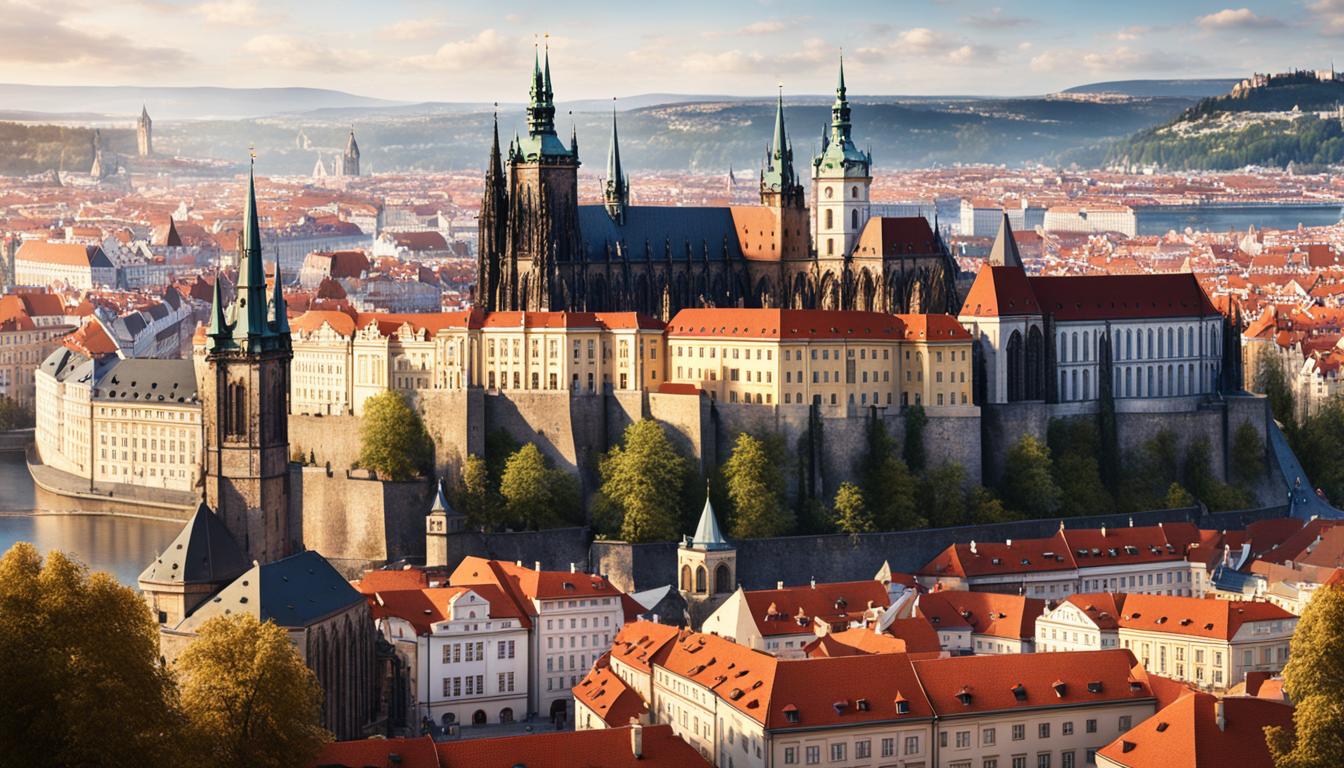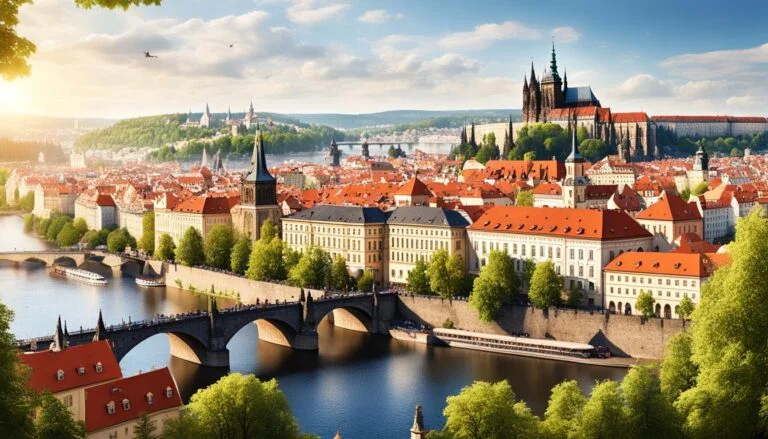Step Back in Time: Explore These Historical Landmarks in the Czech Republic!
Have you ever thought about how a country can be so full of history? The Czech Republic is amazing with lots of old landmarks. They tell stories from long ago. For example, the huge Prague Castle is the biggest old castle in the world. There’s also the magical medieval streets of Český Krumlov.
It’s filled with UNESCO sites, Gothic cathedrals, and Baroque palaces. The stories of strength are everywhere. Places like Kutná Hora and the spooky Sedlec Ossuary are must-sees. So is the Jewish Quarter in Prague with its rich culture.
Every cobblestone street and castle wall invites you to learn. They want you to see the Czech nation’s rich past.
Key Takeaways
- The Czech Republic is renowned for its historical landmarks, including UNESCO sites.
- Prague Castle is celebrated as the largest ancient castle globally and holds significant historical importance.
- Český Krumlov showcases medieval charm and a rich architectural heritage.
- Kutná Hora features the unique Sedlec Ossuary, an artistic display of human bones.
- The Jewish Quarter in Prague reflects the nation’s diverse cultural history.
- Terezín serves as a poignant reminder of the country’s turbulent past.
- Exploring these sites offers a profound insight into the Czech Republic’s vibrant history and heritage.
Discover the Rich History of Prague Castle
Prague Castle stands out in Czech history. For centuries, it was home to royalty. It stretches over 110 acres, making it the biggest castle from old times in Europe. The place shows the Czech Republic’s history through its buildings. Each style tells a different part of its past.
Overview of Prague Castle’s Significance
Prince Bořivoj started Prague Castle in the 9th century. Since then, it has been important for power and culture. Now, it is where the Czech President works. Every year, millions of people visit it. Being named a UNESCO World Heritage site in 1992 shows its value. The castle has many buildings that represent Czech architecture through time.
Architectural Highlights
St. Vitus Cathedral is a key feature. It began in 1344 and it took 600 years to complete. Its stained glass windows are very beautiful. The Old Royal Palace is another highlight. Built between 1493 and 1510, it mixes Gothic and Renaissance styles. The Golden Lane is charming. It was first for the royal alchemists and castle staff. Now, it has cute shops and shows.
Historical Landmarks in the Czech Republic: The Charm of Český Krumlov

Český Krumlov is a beautiful medieval town in South Bohemia. It has a rich history and lovely old buildings. It’s on the UNESCO World Heritage list. The town has winding streets, old landmarks, and a colorful culture. About 15,000 people live there. Český Krumlov mixes the old with the new, attracting tourists from all over.
A Glimpse into the Town’s Medieval Roots
Český Krumlov started in the 13th century. The 16th century was a special time for the town. Many artists, scientists, and alchemists came to live there. Its beautiful medieval look is still there today. When you walk the narrow alleys, you see how well the town has kept its old look. It truly stands out in the Czech Republic.
Český Krumlov Castle
The Český Krumlov Castle is the heart of the town. The Rožmberk family lived there for 300 years, until 1600. The castle is amazing, with Renaissance and Baroque parts. It has lovely gardens and a tower that gives views of the area. The castle also has a special Baroque Theater. It is one of two in Europe that tourists can see. The castle has had European brown bears since the 16th century. They are part of the Rožmberk’s family symbol.
Český Krumlov has a lively arts scene. It hosts summer festivals like the Celebration of the Rose and a music festival. These events keep bringing people here. It’s the Czech Republic’s second-biggest tourist spot. The mix of old times, buildings, and culture makes Český Krumlov a must-visit.
Uncover the Mysteries of the Sedlec Ossuary in Kutná Hora

The Sedlec Ossuary is also called the Bone Church. It is very special in Kutná Hora. Many people find it interesting because it shows bones in an artistic way. It has 40,000 to 70,000 skeletons inside. A woodcarver named František Rint made art with them. He made things like chandeliers and family crests from bones. This place is not just for burying the dead. It is also like an art gallery about life and death.
Uniqueness of the Ossuary
The Sedlec Ossuary is not like other places. It is famous for its bone art and history. Every year, about 200,000 people visit it. They see the beauty made from bones, which is both amazing and serious. The chandelier is very interesting. It has every type of bone in it. Every bone is cleaned carefully. This shows how much work it takes to keep this place special.
Historical Context
History of the Sedlec Ossuary goes back to the 1200s. A monastery started here first. Then, an abbot brought soil from Jerusalem. This made it a famous place to be buried. A Gothic church was built on top in the 1400s. It led to putting bones in patterns under the church. This mix of a holy place and bones makes the Ossuary very important. It makes people think about life and those who are buried there.
Explore the Cultural Heritage of the Jewish Quarter

The Jewish Quarter, Josefov, is rich in culture and history in Prague. It’s been the center of Jewish life for over a thousand years. Today, it shows the history and tradition of Jewish people.
Significance of the Jewish Quarter
This area shows how important Jewish culture is to Prague. It has old synagogues, like the Old-New Synagogue, active since the 13th century. The Pinkas Synagogue is a memorial with over 77,000 names of Czech Jewish Holocaust victims.
Even though it’s small, the quarter is full of history. You’ll need a full day to see everything.
Main Attractions
Key attractions within the Jewish Quarter include:
- Old-New Synagogue: The oldest active synagogue in Europe, dating back to 1270.
- Old Jewish Cemetery: Started in the 15th century, it has headstones that tell history.
- Pinkas Synagogue: It remembers Holocaust victims with their names and dates.
- Spanish Synagogue: Built in 1868, it shows Jewish history through lovely architecture.
- Klausen Synagogue: From 1694, it teaches about Jewish customs and traditions.
The Jewish Museum in the quarter has 40,000 Judaica artifacts. It tells about the Czech Jewish story. New spots like the Franz Kafka Monument near the Spanish Synagogue keep the history alive.
Learn About Terezín: A Somber Historical Landmark

Terezín is a key site in history because of its past during World War II. It was first meant to be a model Jewish settlement. But, it turned into a concentration camp. Over 154,000 people faced terrible times there. Now, Terezín teaches us about the Holocaust. It helps us remember the pain of those who were there.
Historical Significance of Terezín
The story of Terezín is filled with sadness. So many prisoners lived there at once. In September 1942, there were 58,000 people. About 88,000 were sent from there to die in other camps. Roughly 33,000 died in Terezín from being sick and not having enough food. Today, Terezín reminds us of those hard times. It helps teach young people about what happened.
Visiting the Site
If you want to visit Terezín, it’s a short trip from Prague. It takes about 50 minutes by train. You might want to stay all day to see everything. There’s a museum that tells you about the lives of the people who were there. Taking a guided tour is a good idea. This way, you learn a lot about Terezín’s stories. The place is open to everyone. The hours change with the seasons. It’s a place to learn and to think about the past.
Conclusion
The Czech Republic is a place full of history. Every corner tells a story, from the big Prague Castle to the small lanes in Český Krumlov.
You’ll see amazing buildings like the gothic St. Vitus Cathedral. And don’t forget the famous Charles Bridge!
There’s also the Sedlec Ossuary in Kutná Hora. It makes you think about the old days. The Jewish Quarter is full of life and stories.
Love beer? Visit the Pilsner Urquell Brewery in Plzeň. You’ll learn lots and taste great beer.
You can see cool medieval stuff and the famous Terezín. The Lennon Wall is full of colors and life.
The Czech Republic has so much to see. It teaches you about history and culture. Everyone should visit!







